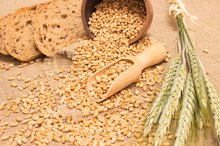What does fact checked mean?
At Healthfully, we strive to deliver objective content that is accurate and up-to-date. Our team periodically reviews articles in order to ensure content quality. The sources cited below consist of evidence from peer-reviewed journals, prominent medical organizations, academic associations, and government data.
The information contained on this site is for informational purposes only, and should not be used as a substitute for the advice of a professional health care provider. Please check with the appropriate physician regarding health questions and concerns. Although we strive to deliver accurate and up-to-date information, no guarantee to that effect is made.
Why Is Iron Added to Cereal?
Iron deficiency, a lack of iron in the body, is common in the very young, the very old and pregnant and menstruating women. Iron carries oxygen in red blood cells; low iron levels cause iron-deficiency anemia. Fortifying cereals, a common breakfast food and one usually accepted by children, with iron helps ensure the daily iron requirements are met. Manufacturers first began fortifying cereals in 1941 to restore cereal to its full whole-grain potential.
Requirements
The daily iron requirement for children age 4 to 8 is 10mg per day; teen boys require 8mg and teen girls 15mg. Adult men need 8mg, compared to adult women who need 18mg, because they lose iron in menstrual blood each month. Pregnant or breastfeeding moms need to up their intake to 27mg per day. Adults over age 50 need 10mg. Fortified cereals contain between 25 and 100 percent of recommended daily values, which are based on people with the highest iron requirements.
- The daily iron requirement for children age 4 to 8 is 10mg per day; teen boys require 8mg and teen girls 15mg.
Risks
Most Recommended Food for Anemic Children
Learn More
Iron overdose, as well as deficiency, can cause a number of health problems. Fortified cereals, because they aim to supply the needs of the people most at risk for iron deficiency, can lead to an iron overdose for others. A study conducted by the U.S. Food and Drug Administration examined the actual amounts of iron in fortified cereals. Results, which were published in the June 2001 issue of “Journal of the American College of Nutrition,” found that of 29 fortified cereal studied, 21 contained 120 percent or more of the stated iron amounts and eight contained 150 percent of the dose listed. The range of actual iron was from 80 to 190 percent of the listed value 2. In addition, the study also found that most adults consumed twice as much cereal as was listed as an average serving, meaning that they got twice as much iron as was listed in a single serving.
- Iron overdose, as well as deficiency, can cause a number of health problems.
- Results, which were published in the June 2001 issue of “Journal of the American College of Nutrition,” found that of 29 fortified cereal studied, 21 contained 120 percent or more of the stated iron amounts and eight contained 150 percent of the dose listed.
Benefits
Many children get about half their daily iron requirement from fortified cereals, pediatrician and author William Sears, M.D. reports. Iron-deficiency anemia decreased in American middle-class children from 6.2 percent between 1969 and1973 to 2.7 percent by 1986, the 2001 FDA article reported, quite possibly due to the prevalence of iron-fortified cereals. Similar results were found for children from low-income families.
- Many children get about half their daily iron requirement from fortified cereals, pediatrician and author William Sears, M.D.
- reports.
- Iron-deficiency anemia decreased in American middle-class children from 6.2 percent between 1969 and1973 to 2.7 percent by 1986, the 2001 FDA article reported, quite possibly due to the prevalence of iron-fortified cereals.
Absorption
Does Iron Deficiency Cause Headaches?
Learn More
The iron in cereal is nonheme iron, which is less well absorbed than iron that comes from animal sources. To increase iron absorption from cereal, eat foods or juice high in vitamin C at the same time as fortified cereals, because vitamin C aids iron absorption. Eating a heme source of iron at the same time also increases nonheme iron absorption.
Related Articles
References
- Ask Dr. Sears: Choosing Cereal
- Office of Dietary Supplements: Iron
- Abbaspour N, Hurrell R, Kelishadi R. Review on iron and its importance for human health. J Res Med Sci. 2014;19(2):164–174.
- National Heart, Lung, and Blood Institute. Iron-Deficiency Anemia.
- Vaucher P, Druais PL, Waldvogel S, Favrat B. Effect of iron supplementation on fatigue in nonanemic menstruating women with low ferritin: a randomized controlled trial. CMAJ. 2012;184(11):1247-54. doi:10.1503/cmaj.110950
- Stugiewicz M, Tkaczyszyn M, Kasztura M, Banasiak W, Ponikowski P, Jankowska EA. The influence of iron deficiency on the functioning of skeletal muscles: experimental evidence and clinical implications. Eur J Heart Fail. 2016;18(7):762-73. doi:10.1002/ejhf.467
- Cherayil BJ. The role of iron in the immune response to bacterial infection. Immunol Res. 2011;50(1):1–9. doi:10.1007/s12026-010-8199-1
- Jáuregui-lobera I. Iron deficiency and cognitive functions. Neuropsychiatr Dis Treat. 2014;10:2087-95. doi:10.2147/NDT.S72491
- Cleveland Clinic. How to Tell If You Have Iron Deficiency Anemia. Updated October 30, 2017.
- Murat S, Ali U, Serdal K, et al. Assessment of subjective sleep quality in iron deficiency anaemia. Afr Health Sci. 2015;15(2):621–627. doi:10.4314/ahs.v15i2.40
- Dosman CF, Brian JA, Drmic IE, et al. Children with autism: effect of iron supplementation on sleep and ferritin. Pediatr Neurol. 2007;36(3):152-8. doi:10.1016/j.pediatrneurol.2006.11.004
- Office of Dietary Supplements. Iron Fact Sheet for Health Professionals. Updated October 16, 2019.
Writer Bio
A registered nurse with more than 25 years of experience in oncology, labor/delivery, neonatal intensive care, infertility and ophthalmology, Sharon Perkins has also coauthored and edited numerous health books for the Wiley "Dummies" series. Perkins also has extensive experience working in home health with medically fragile pediatric patients.









